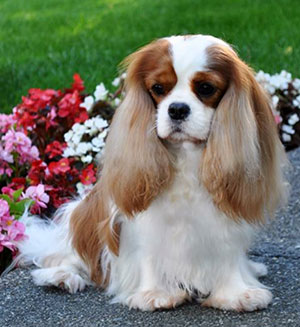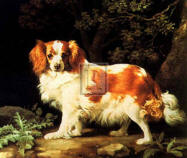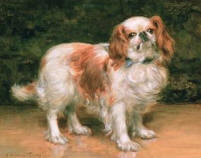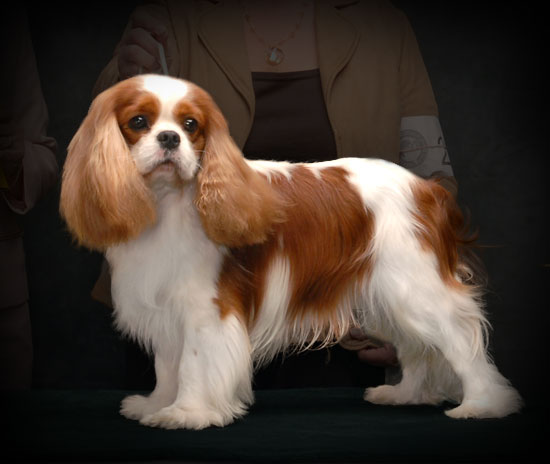About the Breed
The Companion Cavalier
 Bred for centuries to be a companion dog, Cavaliers, referenced in history as “the spaniel gentle" make an ideal addition to almost any family. A sweet, affectionate and gentle spaniel, yet still of a sporting nature, full of curiosity, even small feats of mischief, these little dogs are worthy of their royal status in society. Having no self protection instinct, they cam approach any stranger and venture into un-chartered territory without a second thought.
Bred for centuries to be a companion dog, Cavaliers, referenced in history as “the spaniel gentle" make an ideal addition to almost any family. A sweet, affectionate and gentle spaniel, yet still of a sporting nature, full of curiosity, even small feats of mischief, these little dogs are worthy of their royal status in society. Having no self protection instinct, they cam approach any stranger and venture into un-chartered territory without a second thought.
It is these endearing qualities that make them a wonderful companion or family pet, a dog that greets everyone it passes with the same enthusiasm and sure to be their new best friend. But this also means that they do not fear things that may harm them, and must be protected by their owners. Cavaliers rarely consider the possibility of danger, a fenced or secured area for them is essential. When outside those areas, they should be kept on a leash. Their abundance of personality in a neat little package makes them the ideal small-breed spaniel. Far from being barky, yappy, or nervous, they are curious, happy, and welcoming.
Historically considered A natural “wash and wear” breed, with a silky soft coat, requiring no clipping or trimming, making for easy grooming, is not so much the case once the dogs are older, especially those that are spayed & neutered. Although they do not need clipping like some breeds, they are considered a coated breed and that does require some maintainance to keep tangle free. The popular long slippers on the feet will continue to grow so keeping those cut back on your pets with a good pair of shears as well as keeping the pads free from hair & nails trimmed will be an ongoing maintainance. They do shed a little but that can be kept minimal with brushing and bathing each week or two. Always feed a premium dog food, and maintain an ideal weight. Provide a source of exercise, keep up on vaccinations and annual check ups with the vet and your Cavalier will be a healthy, happy addition to your family.
History

The ancestry of the Cavalier can be traced back to the 15th century in noble European societies. Charles II returned from exile in France and was crowned King of England in 1660, bringing with him his toy spaniels. He was known to have dozens around him all the time.
James II, succeeded the throne in 1685, and they continued to maintain royal status during his reign. Queen Mary I and William of Orange, took the throne in 1689, preferring the flat-nosed Chinese Pug. It is during this time, with the influence of the Pug, that the small toy spaniels began a transformation from the longer-nosed, tapered muzzle to the flat-faced spaniel commonly known today as the “King Charles Spaniel” or “English Toy Spaniel."

In 1926, an American. Roswell Eldridge, challenged breeders of the flat-nosed “King Charles Spaniel” to re-create the breed as it had been portrayed during the time of King Charles II. The reward offered twenty five pounds sterling, a lot of money in those days, to the best dog and best bitch.
Still a popular & coveted event today, the famous Crufts Dog Show in England, held the judging for the contest of the newly re-created Cavalier in 1927. The dog (male) winner, “Ann’s Son” was chosen as the best representative of the breed. “Ann’s Son” along with paintings of the longer-nosed spaniels during Charles the II time, modeled the breed standard for the Cavalier King Charles Spaniel of today. Resulting from this contest were the 6 foundation dogs for the newly created breed which all of today's purebred Cavaliers can be traced back to. In 1945 the governing English Kennel Club agreed to grant separation in the registry, distinguishing the flat-nosed “King Charles Spaniel” from the longer-nosed “Cavalier King Charles Spaniel”.

The original registering body for the breed in the United States, the CKCSC-USA (Cavalier King Charles Spnail Club-USA) was formed in 1956. The breed gained AKC (American Kennel Club) recognition in 1996, of which the CKCSC-USA registry served as AKC’s foundation stock registration platform. The American Cavalier King Charles Spaniel Club (ACKCSC) was established in 1995 and granted "parent club" status for the breed with the AKC in 1996. These are the only two legitimate Cavalier registries in the United States.
Health

Robyn Christensen with her 12.5 yr old
CH. Covington Meydenbauer Bell
Photo by: Eric Ahrendt
For more comprehensive information on these conditions as well as other canine health concerns that can also effect the Cavalier, please refer to the Health pages on the ACKCSC & CKCSC-USA websites, availalbe on our links page, as well as other Health links provided for your convenience.
As with all pure bred dogs, Cavaliers are not without their health concerns. It is fair to note that all genetics, good and bad, were compounded when the breed was re-created in 1927, at which time 6 foundation dogs became the groundwork from which all purebred Cavaliers today can be traced. This fact alone emphasizes how small the gene pool is for the breed. Some problems in the breed are of more proportionate concern than others, and more challenging for breeders to manage. However, as a whole, cavaliers are a hardy, healthy little spaniel. Reputable breeders will have a good knowledge of pedigree traits and attempt to breed from stock that posses good hardy longevity with plenty of health testing behind them.
Eye, hip, and patella problems do exist in all toy breeds, including Cavaliers, however they are conditions that can be checked. Responsible breeders will have very few incidences of these conditions in their puppies. Still, recessive genes exist and can crop up when least expected even with the most exceptional breeders.
Mitral Valve Disease (MVD) and Syringomyelia (SM) prove much more challenging problems to the breed and breeders and are topics you will want to discuss with your breeder before purchasing a puppy. Currently there are no gene isolation tests for either. Both these conditions have been the main focus of resource allocation of funds to genetic research, by breed clubs Health Foundations and Charitable Trusts funds, of which those funds are donated to by dedicated breeders and pet owners. The actual mode of inheritance, genetic and environmental factors that influence these conditions are still unknown. Responsible breeders do a good job minimizing the number of cases of SM effected dogs & early onset MVD.
Mitral Valve Disease (MVD)
Mitral Valve Disease, caused by endocardiosis, polysaccharide deposits in the valve leaflets which distorts the valve and allow it to leak. Although common in most breeds & nearly all toy dogs, it seems to present earlier in the cavalier. Cardiologist statistics world wide, indicate that about 50% of cavaliers will develop at least a mild heart murmur by the age of 5 years, 70% by age 7 and over 98% by the age of ten. Cavaliers can still lead perfectly normal lives for many years after developing a murmur, as the breed in general has adapted to the condition,. Some may evenutally need medication to help with symptoms & comfort in later years. A very small percentage can progress quickly with the condition despite medication. Eradicating this condition completely is not possible and it is fair to say that nearly all Cavaliers will eventually get a heart murmur, but continuing to focus on later onset is the constant goal. Knowing pedigree's, when the dogs within the pedigrees have gotten murmurs, how well those dogs lived with their murmurs as well using annual heart screening as a tool on our breeding dogs are all important aspects that need to come together to produce dogs with later onset MVD that also can live long quality lives after onset with slow progresssion of murmurs.
Syringomyelia (SM)
The most common symptoms of Syringomyelia are hypersensitivity in the neck area resulting in an uncontrolled urge to scratch at the neck and shoulders especially when excited or when irritated with a collar on. This behaviour can give the appearance of air scratching while walking. There often is discomfort and pain in the area of the neck, ears and shoulders. Progressive muscle weakness in the limbs may also be evident. Fortunately very few dogs actually develope symptoms from syringomyelia and the ones that do respond well to medications. In some very rare cases symptoms can be severe & life altering for the dog requiring special care. Syringomyelia is defined as a condition that results in the development of fluid-containing cavities within the parenchyma of the spinal cord as a consequence of abnormal cerebrospinal fluid movement through the foramen magnum. SM is thought to develop secondary to an obstruction of cerebrospinal fluid flow at the level of the foramen magnum. A cause of SM is an inappropriately small or developed occipital bone. This malformation Chiari-like malformation (CM), a condition that appears similar to "Chiari type 1" malformation in humans. The identification of this disease in Cavaliers is relatively new. With the ability to study the condition using MRI, it has been discovered that CM exists in 98% of Cavaliers, so we don't know how much CM may have always existed in the breed. It is thought that CM can cause SM, which may or may not result in dogs with symptoms. CM/SM is known to exist, in research so far, in over 38 other breeds, some just as prevenlent as the Cavalier. There is also conflicting data that SM exists without CM. So far mandatory subsidized MRI studies in some European countires, have proven that breeding clear scanned dogs together unfortunately does not eliminate the condition. There continues to be lots of debate this subject.